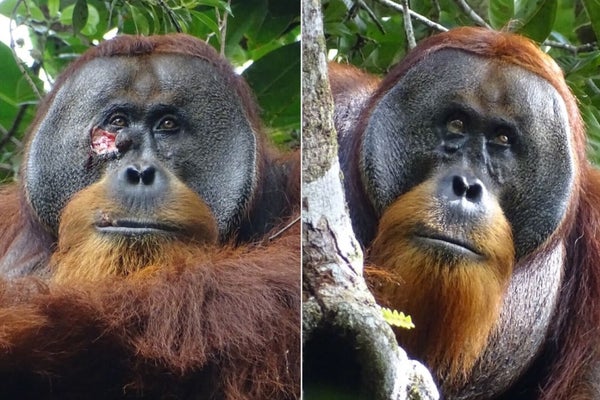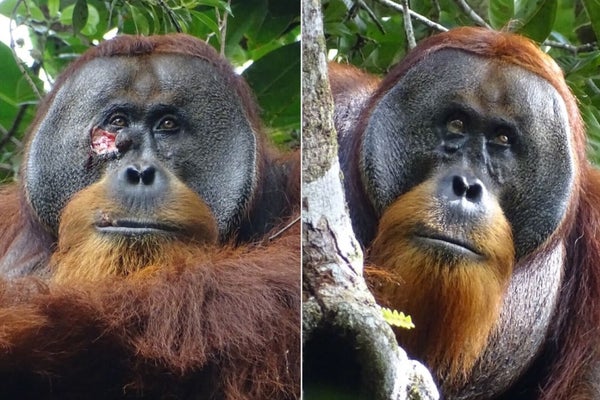Wild Orangutan Uses Herbal Medicine to Treat His Wound
Researchers say this may be the first observation of a nonhuman animal purposefully treating a wound with a medicinal plant

The adult male orangutan Rakus was photographed with a facial wound on June 23, 2022 (left). Two days later he applied chewed leaves from an akar kuning plant to the wound. By the time he was photographed again on August 25, 2022 (right), the wound was barely visible.
Armas(left); Safruddin (right)
Deep in the rain forests of Indonesia, there’s no such thing as running to the pharmacy for soap and bandages to tend to a fresh wound. People living in the area have coped by turning the forest itself into a pharmacy, using its plants as medicine—and new evidence shows that at least one nonhuman primate has done so as well. The remarkable observation may be the first time a wild animal has been observed self-medicating with a plant with known therapeutic properties.
Meet Rakus, a male orangutan now likely in his mid-30s, who was first seen in the Suaq Balimbing research area in 2009. In June 2022 researchers monitoring the 150 orangutans in the neighborhood noticed something unusual: Rakus was injured, with an open wound on his flange (a large, flat “cheek” structure that surrounds his face, characterizing him as a sexually mature male orangutan). And he seemed to be purposefully applying plant sap and crushed leaves to the wound—almost like a poultice—according to research describing the behavior, which was published on May 2 in Scientific Reports. “This is a fascinating example of intentional wound treatment in wild orangutans,” says Cheryl Knott, a biological anthropologist at Boston University, who was not involved in the new study. “We’ve never seen anything like this.”
In recent decades, scientists have collected numerous observations of many types of animals taking care of themselves. Such behaviors, termed “self-medication,” can be as common as avoiding contaminated food or not eating when feeling unwell. But more complex instances of self-medication—eating foods that proactively keep one healthy or that retroactively address an ailment, for example—are quite rare among animals.
On supporting science journalism
If you’re enjoying this article, consider supporting our award-winning journalism by subscribing. By purchasing a subscription you are helping to ensure the future of impactful stories about the discoveries and ideas shaping our world today.
Rakus’s behavior represents the rarest category: an animal applying a plant to its body or nest to benefit its health. It’s even less common to see an animal treating an external wound with a plant scientists know to have medicinal properties in humans. Rakus’s apparent first aid is the only such example known to date—in the most similar previous occurrence, orangutans merely applied such a plant to their upper arms or legs rather than a specific injury.
“This case is very special because in this case it’s with a very potent healing plant,” says Isabelle Laumer, a cognitive biologist and primatologist at the Max Planck Institute of Animal Behavior in Radolfzell, Germany, and a co-author of the new research. The leaves Rakus used came from a plant known locally as akar kuning (Fibraurea tinctoria), which grows across large swaths of China, Southeast Asia and Indonesia, Laumer says.
Humans have long recognized this plant’s beneficial properties, which include pain relief, inflammation reduction, and antibacterial and antifungal characteristics. And the plant appeared to help Rakus, too. “We couldn’t observe any signs of wound infection, and the wound healing was very rapid,” Laumer says. “After a few days, the wound had fully closed.”
The researchers aren’t sure what inspired Rakus to use akar kuning on his wound. Although it’s a common plant in the area, previous observations have shown that orangutans there only occasionally munch on it. Rakus may have selected the beneficial plant by chance rather than doing so because of knowledge or suspicion of its characteristics, Knott says. “Whether he knew that this particular plant had certain properties as opposed to another plant, that’s hard to say,” she adds.
Andrea DiGiorgio, a biological anthropologist at Princeton University, who was not involved in the new research, argues that the observation is a helpful reminder that animals don’t need to understand the mechanism behind a behavior to recognize its value—just like humans may understand the basic idea of a bandage but not more complicated medical interventions. “I think this really speaks to the intelligence that all animals have to utilize what works for them,” she says.
It’s also unclear whether Rakus innovated the behavior himself or copied it from another orangutan. Male orangutans establish home territories far from where they were born, so the scientists can’t investigate whether individuals he grew up with were already practicing wound care, Laumer says. In addition, males spend very little time with any orangutans besides their own mother, leaving few opportunities to pick up the behavior from another animal.
Knott says this research underscores how even long-term monitoring of orangutans at this and other sites gives researchers only a glimpse of each animal’s daily routine, with poor odds of catching unusual, intriguing behaviors like Rakus’s.
“We’re only observing them for a small part of each individual’s life,” she says. “My project’s been going on for 30 years, and we haven’t observed this. That just shows the importance of this kind of long-term monitoring in revealing rare behaviors.”

